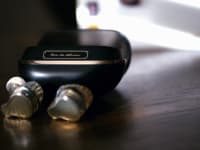Pros
-
Comfortable
-
Great sound and microphone
-
Atmos-ready
Cons
-
Wireless range is spotty
-
Atmos could be stronger
Boasting compatibility with PC, Mac, PS4, and PS5, the HS80 delivers a lot of goods for its price: durable materials, smart design, great sound (with or without virtual Atmos spatial audio), and a reliable, broadcast-grade microphone. While its Atmos-driven surround presentation isn’t the best we’ve heard, it’s certainly appreciable, and the build and audio quality help justify the HS80’s price tag.
Other than a small issue with the wireless transmitter range, the HS80 is almost flawless and delivers oodles of value for what you’re paying. You aren’t getting a $300 Dolby Atmos caliber headset, and the RGB effects are a little on the underwhelming side, but if you’re okay with those being icing on the cake rather than selling points, the Corsair HS80 RGB Wireless could be an awesome addition to your gaming arsenal.
About the Corsair HS80 RGB Wireless
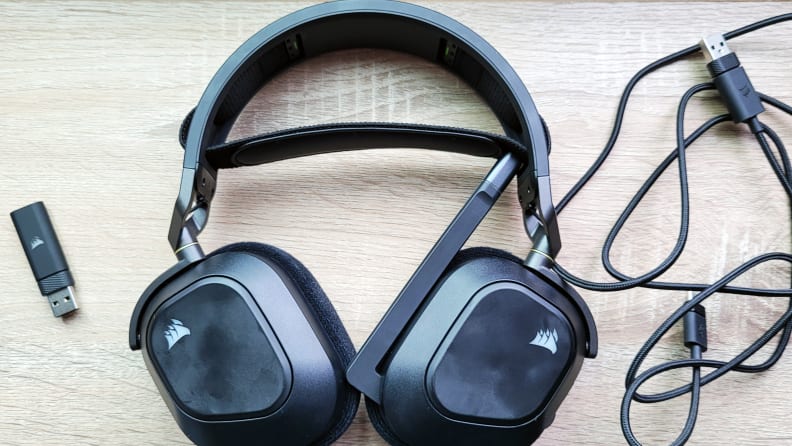
In the box, you're also getting a durable USB-C charging cable and a Corsair-branded USB wireless transmitter.
Here are the headset's notable specs at a glance:
- Cost: $150
- Style: Over-ear
- Colors: Black
- Drivers: Custom 50mm neodymium
- Connection: USB transmitter (PC, Mac, PS4, PS5)
- Wireless range: Up to 60 feet
- Battery life: Up to 20 hours
- Microphone: Omni-directional broadcast-grade
- Weight: 367 grams
- Virtual Surround Sound: Dolby Atmos (PC only)
The wireless HS80 RGB is the newest addition to Corsair’s “HS” line of pro-gamer-facing headsets. Compared to the older HS70 model, the HS80 adds Dolby Atmos compatibility (for PC) and RGB functionality, the prime reasons you’re paying an extra $50 for it.
Alongside the headset, you'll get a wireless USB transmitter, a USB-C charging cable, and a quick start guide. We tested our Corsair HS80 RGB demo unit with a Windows 10 PC.
What we like
Durable, comfy, and easy to use
Wire-free, outfitted with a “floating” stabilizer band, and equipped with cloth-padded ear cups, the HS80 is super comfortable—important for any headset, but especially the HS80 since its viable for work meetings and listening to music in addition to gaming. If you work and game from the same desk, you could end up using the HS80 for 8-12 hours a day.
The materials used to make the HS80 show Corsair’s attention to quality. The headband is a mix of high-quality, slightly-yielding plastic and metal, which adds a good deal of weight (the HS80 weighs over 100 grams more than our current favorite wireless headphones, for reference). Fortunately, the stabilizer—an elastic strap with adjustable velcro tension points mounted on the inside of the headband—does a great job of redistributing the HS80’s weight, making it perfectly palatable over long periods of time.
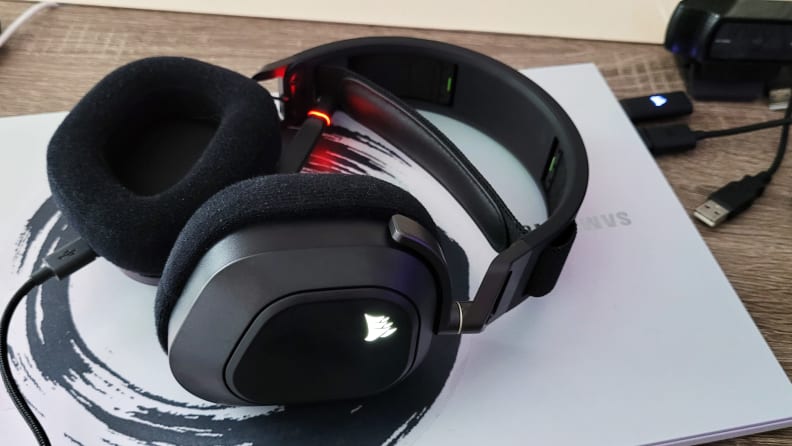
The HS80's durable steel construction, memory foam cups, and stabilizing headband help it stay comfortable for hours.
I only had a few small complaints about the design. First, the HS80’s design is that the memory foam, cloth-covered cups feel splendid against my temples and ears, but they don’t breathe very well. It may be because I’m used to open-backed headphones, but I found myself noticing heat buildup after around 45 minutes of use. It's not a huge issue, but can get a bit stuffy.
In addition, while the material is lovely, it also has a tendency to gather particulates (like cat hair) and hang onto them until you clean the cups off. But other than those minor quibbles, Corsair deserves praise for the emphasis on durability and comfort here.
The attached microphone is also well made: when folded up in its “mute” position, its firm plastic holds the mic vertically, keeping it out of the way and out of your field of vision. When flipped down in its unmuted position the LED changes from red to white, and the microphone activates. The range of motion on the mic arm is quite generous, and there’s something satisfying about snapping it up into place. As an aside, the reviewer’s guide mentions that the mic is detachable, but I was unable to remove it without fear of breaking something.

When flipped up, the microphone mutes and its LED indicator turns red; when you flip it down, it activates and lights up white.
The intuitive nature of the flip-up-to-mute, flip-down-to-unmute extends to controlling the headset itself. On the back of the right cup, you’ll find a button for power and a scroll wheel for volume. You can also press the wheel to jump through EQ presets (though not when Dolby Atmos or other spatial listening modes are active).
The USB-C charging port is on the bottom of the right cup, and yes, you can keep listening over USB while you charge the battery—always a great feature! The semi-rigid, fabric-wrapped USB cable may constantly bump your shoulder or neck because of the port placement, but I appreciate how durable the charging cable is, so that’s not a hill I’m going to die on complaints-wise. Likewise, the USB dongle (for wireless connection) is a surprisingly high-quality piece, even featuring its own light-up Corsair logo. Just plug it into your PC and you’re good to go (the process is slightly more involved for PlayStation).
Speaking of things lighting up, it wouldn’t be an RGB headset without some rainbow lights. Using Corsair’s “iCue” app (more about that in a bit), you can control the RGB effects for the HS80, but the display of colors here is understated—this might be disappointing if you’re not into subtlety.
The only portion that displays RGB effects are the tiny Corsair logos on the back of each cup. When I showed my fiancee what it looked like, she wondered aloud, “What’s the point if you can’t even see them?” and I was inclined to agree; I’d been using the Rainbow scene from iCue all day, and whenever I take the headset off I’m treated to a light show, but you can’t see it while you’re wearing them.
Great sound, reliable microphone
I sampled a fairly wide range of sources to test the HS80—my usual Spotify playlists, music that was mastered in Dolby Atmos, and, of course, plenty of video games, including Skyrim and a number of native PC titles with Dolby Atmos sound support. No matter what I threw at it, the HS80 sounded great.
Music-wise, the HS80 sounds about as good playing music as a similarly priced pair of wireless headphones, even without Atmos-mastered tracks.
Dolby Atmos-mastered games like Grounded allow the headset to show off its ability to represent three-dimensional space, which is a lot of fun. This virtual estimation of Dolby Atmos is nowhere near as immersive as what you'll get when surrounded by speakers in a Dolby Cinema theater (more on that later), but it’s better than traditional stereo.

Whether you're listening to music, dealing with a Zoom call, or playing games, the HS80 sounds excellent.
Corsair touts the microphone as being broadcast-quality, so I tried it out in a few settings, including games and Zoom/Skype calls, and the company’s claim seems mostly on par. While some folks originally reported that I sounded muffled, the mic’s voice-isolating function may have been adjusting, as the majority of reports have been that I sound much crisper than usual. As long as the mic is flipped down (unmuted), you can adjust its volume and sidetone (monitoring) right in the iCue app, but the default settings work great.
The standard audio quality here—even for music—is much better than I’d normally expect from a gaming headset, especially one with a price tag somewhat inflated by extras like Atmos support and RGB lighting. But given the quality of the soundstage, the microphone clarity, and the excellent materials, it’s almost like you’re getting those features for free.
Solid battery life
Corsair clamis battery life of 20 hours, which is fairly standard for modern gaming headsets. In my experience, the HS80 may last even longer than that—the iCue app showed the battery at almost full even after using the headset for hours at a time over the course of several days.
While battery performance will vary from gamer to gamer, depending on whether you’re using Dolby Atmos or how often you change RGB modes, it’s clear that you can reliably get at least 20 hours of use from the HS80 per charge.
Decent companion software
After you’ve charged up the HS80 and plugged in its wireless USB dongle, you’re going to want to download Corsair’s iCue software. This isn’t the most robust gaming headset software I’ve encountered, but it’s a useful—perhaps indispensable—addition to the headset.
In iCue, you can create custom listening/user profiles, pick from pre-made RGB lighting Scenes, monitor your machine’s CPU load and internal temperature, and more. The ability to adjust microphone levels and check the headset’s battery make it a pretty necessary part of the experience.
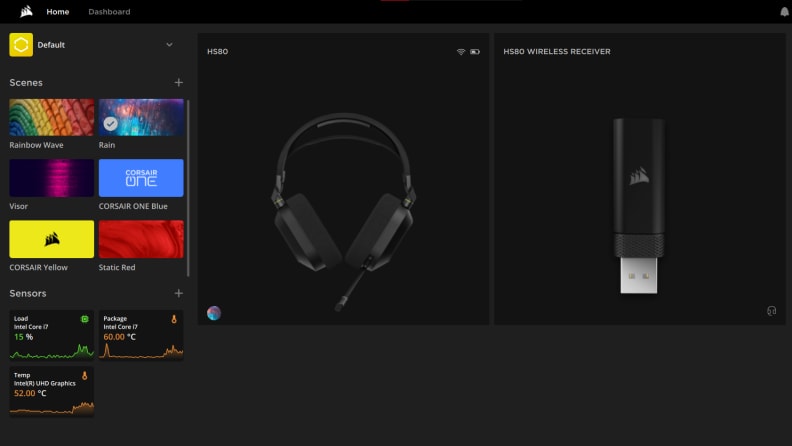
While Corsair's iCue software isn't the prettiest I've ever seen, it's full of useful features and ways to customize your experience.
There’s a wide range of headset-specific adjustments here, too. You’ll have to plug in the headset via its USB charging cable to download firmware updates from iCue, for one, but you can also adjust the RGB LED brightness, toggle auto-shutoff time and voice prompts, and even disable the LED mic status indicator.
My only complaint about iCue is that it feels a little undercooked from a UI perspective. Menus and submenus seem to be thrown together strictly for utility’s sake rather than to create the kind of software that you’ll enjoy using and looking at. But that’s a minor complaint: it gets the job done, and that’s that.
What we don’t like
Wireless distance is spotty
Corsair claims a distance of up to 60 feet between the HS80 and its wireless dongle, but in my experience so far, that distance has been quite a bit less. Walking from my desk to the other side of my apartment, audio from the headset starts to stutter after as little as 20 or 30 feet.
The projected distance of 60 feet may be assuming a completely interference-free environment, meaning the polar opposite of a tech reviewer’s study, but it’s still disappointing how poorly the signal seems to hold up.
While you shouldn’t have any issues at all while using the headset in the same general space as the wireless transmitter, if you’re prone to walking a few rooms away for a snack, you may find the stuttering audio or chat to be a nuisance.
Atmos presentation could be stronger
Dolby Atmos was originally designed for huge, multi-speaker setups, so shrinking it down for stereo headphones and gaming headsets has been a process. But if you’ve heard an in-theater Dolby Atmos demo (or paid a visit to a Dolby Cinema) or experienced a great Dolby Atmos soundbar or home theater system, you’re familiar with the intense immersion made possible by Dolby’s proprietary object-oriented audio format.
That … is not what you’re getting here. While the simulated surround is notable in games and music that support it, it also doesn’t (and can’t) entirely emulate the physical spacing and immersion that Dolby Atmos was designed to create.
For example, while playing Grounded, I could tell that sounds were occurring off to the left or right of me, and the game’s semi-pastoral overworld music seemed to emanate from its own space apart from sound effects in a way that clearly indicated mastered separation. But the Atmos promise of sensing objects moving overhead and all around me was only really hinted at, never fully realized.
Given this headset’s price, what it manages to do by way of virtualizing Doly Atmos audio is fine, but like the RGB functionality, it’s not a selling point. If you’re looking for a highly immersive Atmos gaming experience at home, you may want to consider a soundbar with multiple speakers like Vizio's Elevate
Should you buy it?
Yes, if you want a super solid headset with a touch of Dolby Atmos
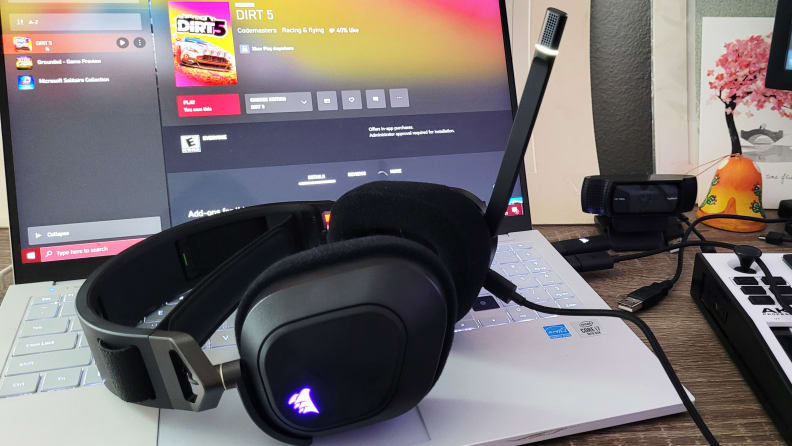
The Corsair HS80 RGB Wireless is durable, comfortable, and sounds great, providing solid value for gaming and general PC use.
The Corsair HS80 RGB Wireless gaming headset checks off a lot of boxes: It’s durable, comfortable, sounds marvelous. It also delivers some winning extras in the form of the iCue app, Dolby Atmos compatibility, and some RGB flair, and works with PC, Mac, PS4, and PS5. (Sorry, Xbox players, you'll want to find something else.)
While we were only able to test the HS80 for PC gaming (meaning there could be Mac or PlayStation-related caveats), the only flaw we discovered was the shorter-than-advertised range on the wireless transmitter, but this is more of an inconvenience than a major issue, and may possibly be fixed during a firmware update. However, buyers should be aware that if they’re hoping for something with highly immersive Atmos surround sound they might be better off with an Atmos soundbar.
For $150, the HS80 is a serious win, especially because it can easily double as both a great gaming headset and a pair of very solid desktop headphones. While it may not have the some of the specialty features you might find in more esports-facing headsets, it’s a terrific value for the price, especially if you already own some Dolby Atmos-ready games.
Meet the tester
Lee was Reviewed's point person for most television and home theater products from 2012 until early 2022. Lee received Level II certification in TV calibration from the Imaging Science Foundation in 2013. As Editor of the Home Theater vertical, Lee oversaw reviews of TVs, monitors, soundbars, and Bluetooth speakers. He also reviewed headphones, and has a background in music performance.
Checking our work.
Our team is here to help you buy the best stuff and love what you own. Our writers, editors, and experts obsess over the products we cover to make sure you're confident and satisfied. Have a different opinion about something we recommend? Email us and we'll compare notes.
Shoot us an email



